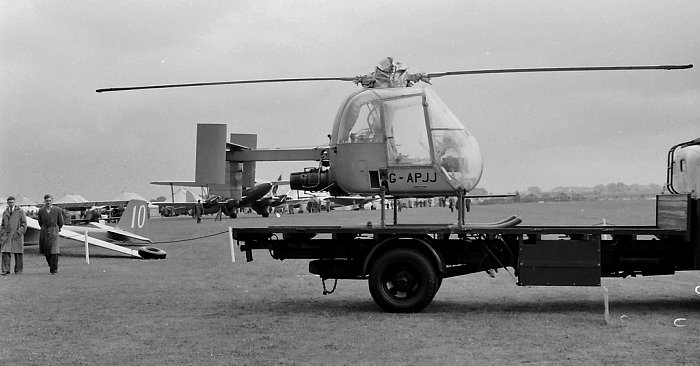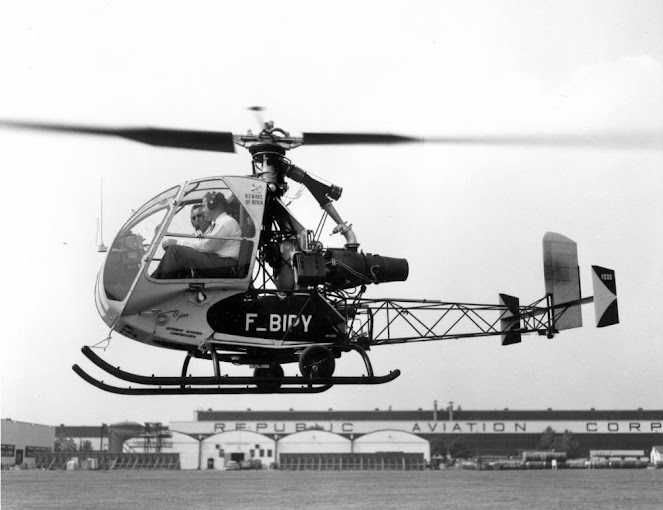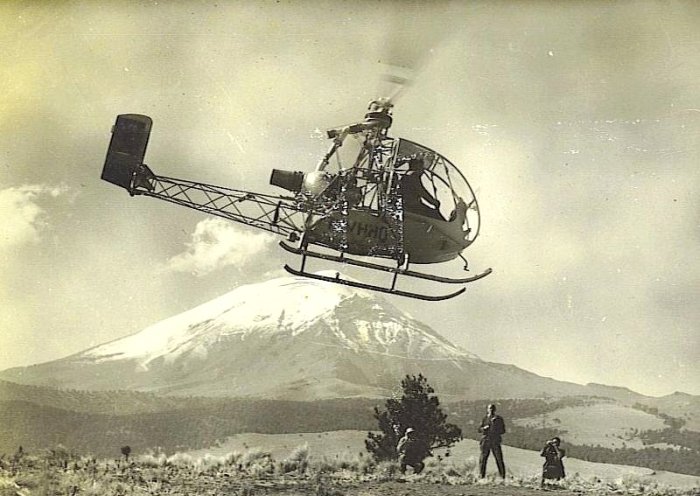C16: One should love to have seen some more evidence of this event!
LOZZ: These are wonderful images, bravo! As EricFerret mentioned, the little yellow craft is the Fairey Ultra-Light, some further details here:
The Fairey Ultra-Light was a two-seat helicopter which used a Turbomeca Palouste turbine engine for propulsion. Air from the centrifugal compressor was sent to the blade tips where it was mixed with the same fuel as was supplied to the turbine to create additional thrust using tiny combustion chambers. The project was originally developed to meet a British Army specification for an aerial observation platform and, in September 1956 and again in 1957, was displayed at Farnborough, operating from the back of a standard truck. It demonstrated outstanding capabilities, in particular, a rate of climb of 6.75m/s and a rate of descent in autorotation of 20m/s. Subsequent development included trials with the Royal Navy, operating from the deck of a destroyer, HMS Undaunted, but the project was eventually cancelled in 1959.
 Fairley Ultra Light G-APJJ during trials with the Royal Navy
Fairley Ultra Light G-APJJ during trials with the Royal Navy
 Fairley Ultra Light G-AOUJ being displayed at the 1957 Farnborough Airshow
Fairley Ultra Light G-AOUJ being displayed at the 1957 Farnborough Airshow
And another shot of G-APJJ (the craft menioned by Planemike):
 Fairey Ultra Light G-APJJ aboard a truck (location unknown). (Photo: The Tony Clarke Collection)
Fairey Ultra Light G-APJJ aboard a truck (location unknown). (Photo: The Tony Clarke Collection)
But .. VFR440 was not far off because the Djinn was an earlier contemporary of the Ultra-Light with the two helicopters sharing several similarities:
The SNCASO (Société Nationale des Constructions Aéronautiques du Sud-Ouest or more commonly, Sud-Ouest) Djinn was the world's first production helicopter to make use of the 'cold jet' principle of propulsion.
The term 'cold jet' indicating that compressed air from the gas turbine engine was ducted through channels inside the rotors and expelled through nozzles at their tips without further combustion. The air itself was evidently warm enough to provide a certain measure of blade de-icing, not that one imagines this to have been a priority. As the Djinn did not require a tail rotor, the aircraft was fitted instead with two out-rigger fins and a large central rudder which was situated in the line of residual thrust from the exhaust (noticeable from the 'soot' marks in the first picture below). Unlike the Ultra-Light, the Djinn went into production with a total of 178 units manufactured.
 Sud-Ouest Djinn
Sud-Ouest Djinn
 More Djinn - this unit 'may' have been delivered to the Argentinian Police (still awaiting confrimation of this detail)
More Djinn - this unit 'may' have been delivered to the Argentinian Police (still awaiting confrimation of this detail)
 The Djinn saw action in the form of utility work across several European nations including France and Switzerland
The Djinn saw action in the form of utility work across several European nations including France and Switzerland
Shane: Your clip first debuted on the thread on page 10 courtesy of Hofmesiter, but its great to see it again! Additional details about Charles Hughesdon and his rotary garden parties appear on pages
10 and
20 plus a black and white photo from Speechless Two's album on page
65 depicting Charles' party from 1963.